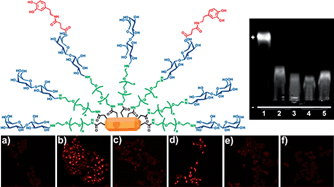Multiple functionalization of fluorescent nanoparticles for specific biolabeling and drug delivery of dopamine†
Abstract
The development of fluorescent biolabels for specific targeting and controlled

Maintenance work is planned for Wednesday 1st May 2024 from 9:00am to 11:00am (BST).
During this time, the performance of our website may be affected - searches may run slowly and some pages may be temporarily unavailable. If this happens, please try refreshing your web browser or try waiting two to three minutes before trying again.
We apologise for any inconvenience this might cause and thank you for your patience.
* Corresponding authors
a National Nanotechnology Laboratory of CNR-NANO, via per Arnesano km 5, Lecce, Italy
b Center for Biomolecular Nanotechnology (CBN) of Istituto Italiano di Tecnologia (IIT), Via Barsanti, Arnesano, Lecce, Italy
c Italian Institute of Technology, via Morego 30, Genova, Italy
d Department of Pharmaceutical and Toxicological Chemistry, School of Pharmacy, “Federico II” University, via Domenico Montesano 49, Naples, Italy
e Istituto di Cibernetica “E Caianiello” (ICIB) of National Research Council of Italy (CNR), Via Campi Flegrei 34, Pozzuoli, Naples, Italy
The development of fluorescent biolabels for specific targeting and controlled

 Please wait while we load your content...
Something went wrong. Try again?
Please wait while we load your content...
Something went wrong. Try again?
M. A. Malvindi, R. Di Corato, A. Curcio, D. Melisi, M. G. Rimoli, C. Tortiglione, A. Tino, C. George, V. Brunetti, R. Cingolani, T. Pellegrino and A. Ragusa, Nanoscale, 2011, 3, 5110 DOI: 10.1039/C1NR10797F
To request permission to reproduce material from this article, please go to the Copyright Clearance Center request page.
If you are an author contributing to an RSC publication, you do not need to request permission provided correct acknowledgement is given.
If you are the author of this article, you do not need to request permission to reproduce figures and diagrams provided correct acknowledgement is given. If you want to reproduce the whole article in a third-party publication (excluding your thesis/dissertation for which permission is not required) please go to the Copyright Clearance Center request page.
Read more about how to correctly acknowledge RSC content.
 Fetching data from CrossRef.
Fetching data from CrossRef.
This may take some time to load.
Loading related content
